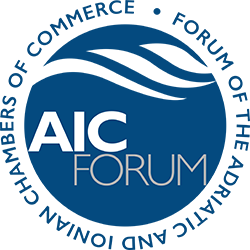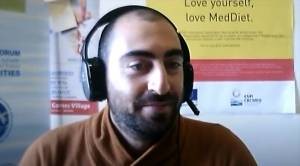On December 1st, 2021, the AI-NURECC PLUS Conference on Creative and Cultural Industries in the Adriatic-Ionian region was held.
The aim of this conference was to contextualise and start mapping the variety of Creative and Cultural Industries (CCIs) existing in the Adriatic and Ionian region. The different kinds of social and economic benefits they can produce, distinguishing between three functional configurations, were at the center of the discussion. The first concerns the educational value of the cultural sector, mainly linked to the realm of public spending for conservation and fruition. The second refers to the economic function of cultural and creative industries, where CCIs are considered for their capacity to generate wealth and income. The third one looks at the economic and physical regeneration that CCIs can play in the process of economic de-industrialization that is affecting urban systems.
Ultimately, the conference focused on the centrality of culture in generating positive change, transformation and creative impulses in individual behaviour. Its capacity to unlock frozen behaviours and generate new ideas for facing the complex challenges of our time. By inviting scholars and practitioners in the field, we aim to systematize and understand the potential of CCIs for the Adriatic and Ionian region.
Opening Session: “AI-NURECC PLUS AS A PLATFORM FOR THE CREATIVE AND CULTURAL INDUSTRIES OF THE ADRIATIC AND IONIAN REGION”
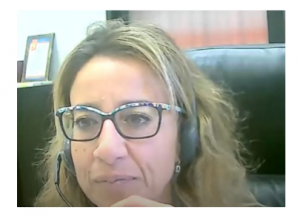
Moderated by Silvia Mangialardo, Head of International Relations Office at Marche Polytechnic University and Representative of UniAdrion, the Opening Session saw greetings from the three Fora presidents.
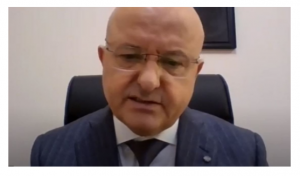 Fatbardh Sallaku, President of the Association of Universities of the Adriatic-Ionian (UniAdrion) – AI-NURECC PLUS Partner, and Rector of the Agricultural University of Tirana, expressed his greeting and his pleasure to be invited to the AI-NURECC PLUS event on Cultural and Creative Industries in the Adriatic and Ionian Region. “The importance of this event is not only for the theme, but also for the collaboration and the number of participants which shows the need and importance of this type of relationship”. The President underlined that the University network must be considered as a crucial point for our future, especially today. The President also suggested a follow-up to this conference called “Creative and cultural relationship and communication” between our Universities and the other players in the area. The President concluded saying: “We are very close to each other but sometimes we lack this kind of information. It is important to know how universities think about competing in this kind of environment!”.
Fatbardh Sallaku, President of the Association of Universities of the Adriatic-Ionian (UniAdrion) – AI-NURECC PLUS Partner, and Rector of the Agricultural University of Tirana, expressed his greeting and his pleasure to be invited to the AI-NURECC PLUS event on Cultural and Creative Industries in the Adriatic and Ionian Region. “The importance of this event is not only for the theme, but also for the collaboration and the number of participants which shows the need and importance of this type of relationship”. The President underlined that the University network must be considered as a crucial point for our future, especially today. The President also suggested a follow-up to this conference called “Creative and cultural relationship and communication” between our Universities and the other players in the area. The President concluded saying: “We are very close to each other but sometimes we lack this kind of information. It is important to know how universities think about competing in this kind of environment!”.
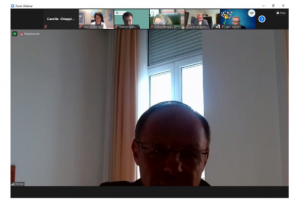 Joze Tomaš, President of the Forum of the Adriatic and Ionian Chambers of Commerce (Forum AIC) – AI-NURECC PLUS Partner, after having presented the Association: “Despite this forced shutdown caused by the pandemic, we strongly wanted the theme of CCIs to be at the core of the AI-NURECC PLUS initiative, which has the objective of identifying and giving credit to the most important cultural and creative sectors in the area. The synergies between the AI-NURECC stakeholders are essential to ensure the development of Cultural and Creative Industries: from university training to the support of local and regional actors (just consider the experiences of the UNESCO cultural and creative cities) and also to the support of chambers of commerce and the economic -financial world”, President Tomaš said. Moreover, Forum AIC supports young generations who want to work in the cultural and creative industry through several initiatives and projects. Among these it is worth mentioning the Adriatic Startup school – promoted by Ecapital Culture in collaboration with the first edition of AI-NURECC initiative – aimed at developing the skills of young people for the realization of a Business Plan in the cultural field and the creation of a start-up for the enhancement of the cultural heritage of the Adriatic-Ionian Region. The Forum AIC president concluded by mentioning that next year the association will be celebrating the twenty-years-anniversary of the establishment of Forum AIC in Split, Croatia; and it will be consecrated precisely to the Creative and Cultural sphere. “We would like to make sure that during the event the cultural and artistic peculiarities of the various countries are enhanced as much as possible, giving the floor to the first source of wealth of the entire Adriatic Ionian Area”.
Joze Tomaš, President of the Forum of the Adriatic and Ionian Chambers of Commerce (Forum AIC) – AI-NURECC PLUS Partner, after having presented the Association: “Despite this forced shutdown caused by the pandemic, we strongly wanted the theme of CCIs to be at the core of the AI-NURECC PLUS initiative, which has the objective of identifying and giving credit to the most important cultural and creative sectors in the area. The synergies between the AI-NURECC stakeholders are essential to ensure the development of Cultural and Creative Industries: from university training to the support of local and regional actors (just consider the experiences of the UNESCO cultural and creative cities) and also to the support of chambers of commerce and the economic -financial world”, President Tomaš said. Moreover, Forum AIC supports young generations who want to work in the cultural and creative industry through several initiatives and projects. Among these it is worth mentioning the Adriatic Startup school – promoted by Ecapital Culture in collaboration with the first edition of AI-NURECC initiative – aimed at developing the skills of young people for the realization of a Business Plan in the cultural field and the creation of a start-up for the enhancement of the cultural heritage of the Adriatic-Ionian Region. The Forum AIC president concluded by mentioning that next year the association will be celebrating the twenty-years-anniversary of the establishment of Forum AIC in Split, Croatia; and it will be consecrated precisely to the Creative and Cultural sphere. “We would like to make sure that during the event the cultural and artistic peculiarities of the various countries are enhanced as much as possible, giving the floor to the first source of wealth of the entire Adriatic Ionian Area”.
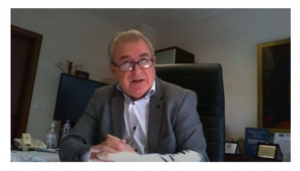 Ioannis Lolos, President of the Forum of Adriatic and Ionian Cities (FAIC) – AI-NURECC PLUS Partner. He briefly presented the FAIC Association, whose aim is to represent a tool for economic, political, cultural and human cooperation, broadly in line with the European Union Strategy for the Adriatic Ionian Region (EUSAIR). All the 43 cities members to the FAIC are cultural and creative cities, where “cultural”, according to the UNESCO declaration of 1982, means the complex of spiritual, material, intellectual and emotional characteristics that characterize a society or social group.
Ioannis Lolos, President of the Forum of Adriatic and Ionian Cities (FAIC) – AI-NURECC PLUS Partner. He briefly presented the FAIC Association, whose aim is to represent a tool for economic, political, cultural and human cooperation, broadly in line with the European Union Strategy for the Adriatic Ionian Region (EUSAIR). All the 43 cities members to the FAIC are cultural and creative cities, where “cultural”, according to the UNESCO declaration of 1982, means the complex of spiritual, material, intellectual and emotional characteristics that characterize a society or social group.
“Our cities express all these levels of “culture” in a remarkable way: we have a millennial cultural heritage, representing a culture over the century, which is still visible in our cities today; it is reflected in the products we produce and in the way of our lives. Our cities can be at the heart of this process. The cultural and creative industries will play this important role in the Adriatic and the Ionian, as they are characterized by a high level of innovation and creativity and are closely linked to local communities and regional networks, contributing to the transition to a “sustainable”, “smart” and an “inclusive” economy. Moreover and above all, it requires a system of values and a social tension that our communities are certainly capable of facing and leading”.
After Presidents’ speeches, it was the turn of:
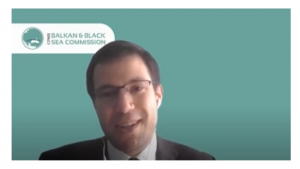 Stavros Kalognomos, Executive Secretary of the Balkan and Black Sea Commission (BBSC),Conference of Peripheral Maritime Regions (CPMR) – AI-NURECC PLUS Coordinator. He opened by saying that AI-NURECC Plus is a capitalization of the results of the AI-NURECC initiative and the thematic of the Cultural and Creative Regional Ecosystems, elaborated by AI-NURECC partners, demonstrates how projects work. Creative and cultural industries are mentioned as one of the studies for the next period. This AI-NURECC thematic area aims to bring together stakeholders in a sector characterized by a variety of professionals. “Improve the lives, transform communities and generate skills and jobs in this sector is a priority of this action”. For this purpose young participants are invited to follow the AI-NURECC events: there will be internships dedicated to them, with participants geographically balanced, and AI-NURECC is happy to receive suggestions from young people, and not only them.
Stavros Kalognomos, Executive Secretary of the Balkan and Black Sea Commission (BBSC),Conference of Peripheral Maritime Regions (CPMR) – AI-NURECC PLUS Coordinator. He opened by saying that AI-NURECC Plus is a capitalization of the results of the AI-NURECC initiative and the thematic of the Cultural and Creative Regional Ecosystems, elaborated by AI-NURECC partners, demonstrates how projects work. Creative and cultural industries are mentioned as one of the studies for the next period. This AI-NURECC thematic area aims to bring together stakeholders in a sector characterized by a variety of professionals. “Improve the lives, transform communities and generate skills and jobs in this sector is a priority of this action”. For this purpose young participants are invited to follow the AI-NURECC events: there will be internships dedicated to them, with participants geographically balanced, and AI-NURECC is happy to receive suggestions from young people, and not only them.
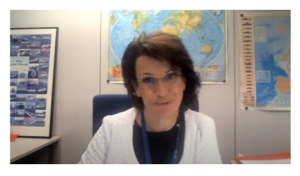 Eleni Hatziyanni, Policy Officer – DG Mare Unit A3 | Sea-basin Strategies, Maritime Regional Cooperation & Maritime Security, EU Commission. DG Mare and Blue Economy are connected with AI-NURECC activities. We can find activities related to the Adriatic and Ionian sea under the umbrella of the EUSAIR. All the countries are having the opportunity to collaborate for common priorities through pillar 1 and related cross cutting activities. Cross-border cooperation is very important in this area.
Eleni Hatziyanni, Policy Officer – DG Mare Unit A3 | Sea-basin Strategies, Maritime Regional Cooperation & Maritime Security, EU Commission. DG Mare and Blue Economy are connected with AI-NURECC activities. We can find activities related to the Adriatic and Ionian sea under the umbrella of the EUSAIR. All the countries are having the opportunity to collaborate for common priorities through pillar 1 and related cross cutting activities. Cross-border cooperation is very important in this area.
The European Green Deal calls for a sustainable transformation of the European economy and the blue economy is part of this green and digital transition so what we try now is to achieve the recovery and innovation after the pandemia, addressing the blue sectors and investing for a sustainable development.
AI-NURECC can contribute in achieving sustainability, through innovative projects, because this initiative is able to engage the Public Authorities, the private sector, the civil Society and the Citizens, the small and medium Enterprises. The smart specialization strategies are a key tool for the Countries and for the Regions to invest in blue economy sectors . The thematic of AI-NURECC is very connected to blue growth: this very good partnership can be further enriched by addressing new innovative activities for professionals and investors dealing with coastal and under-water environments.
A lot of maritime sectors can benefit from this innovative partnership. She invites to broaden stakeholder involved with an event dedicated to facilitating the discussion on the topic.
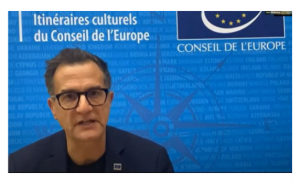 Stefano Dominioni, Executive Secretary of Enlarged Partial Agreement on Cultural Routes of the Council of Europe and Director of the European Institute of Cultural Route.
Stefano Dominioni, Executive Secretary of Enlarged Partial Agreement on Cultural Routes of the Council of Europe and Director of the European Institute of Cultural Route.
The Cultural Routes is related to the thematic of the Adriatic and Ionian region. The scope is to put into practice the fundamental values of the Council of Europe: human rights, cultural diversity, intercultural dialogue and mutual exchanges across borders.
The aim is to promote a better understanding of European cultural identity, preserving and enhancing natural and cultural heritage as the source of sustainable development. The Cultural Route network aims to implement activities to strengthen cultural practices and exchanges between people, coming from different cultures and backgrounds, thus reflecting the living and dynamic features of culture. Cultural Routes represent a vector for local economies and activities. They have to ensure the sustainable cultural tourism and the sustainable economic development along the route.
The Cultural Routes program continues to grow with 7 new applications received this year. Post pandemic the Cultural Routes can become tools for local development to provide innovative and sustainable solutions to new future challenges and to overcome the difficulties imposed by the Pandemic. 90% of the cultural routes cross rural areas. They allow the integration of the main european touristic offers with the minor destinations, to create tourist flows to less developed areas. Of course these Routes cross the Adriatic and Ionian macroregion and in 2018 a Road Map dedicated to his sites was published, in the framework of a Joint Actions with the European Commission. In this publication there are suggestions and recommendations for stakeholders and Authorities working in the fields of sustainable tourism, cultural cooperation and social participations.
This Road Map underlines how some countries are underrepresented and need to be involved, since the Routes have a social impact on the territories and benefits on the regions.
Through its programme, the Council of Europe offers a model for transnational cultural and tourism management and allows synergies between national, regional and local authorities and a wide range of associations and socio-economic actors. This AI-NURECC conference is useful to underline how big is the variety of CCIs in the area and how they can be used for sustainable tourism.
PANEL 1: “THE ADDED VALUE OF CULTURAL AND CREATIVE INDUSTRIES FOR THE ADRIATIC AND IONIAN AREA”
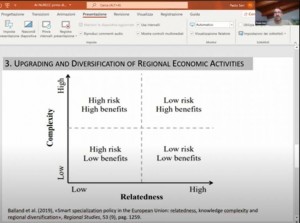
Then, Paolo Seri, Adjunct Professor of Territorial and Environmental Economics, Marche Polytechnic University (Italy), took the floor to introduce the first panel and its speakers.
First of all he analyzed the context giving a functional perspective on cultural and creative activities: CCIs activities are useful to build a sense of belonging to regionally shared identities, to generate occupation and wealth. CCIs activities are also useful to unlock frozen behaviour, cognitive anchoring and regional lock-in. The regeneration of urban spaces is important to focus on the European “Urban Agenda”, that is based on reduction of the ecological footprint of cities, the upgrading of the economic city and the transformation of the physical city, but also on the reduction of inequalities and the extension of the Urban responsibilities to the hinterlands. The question that the professor asks is “Is there an EUSAIR Urban Agenda?”. It would be very useful to coordinate the two Agendas: Adriatic and Ionaian sea can’t be used as a landfill. Moreover, it is important to understand the complexity of the Regional Economic Activities and to diversificate them, basing on their level of relatedness.
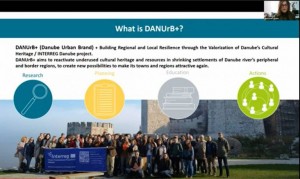 Aleksandra Djukić, Associate Professor at the Faculty of Architecture, University of Belgrade (Serbia), presented the DANUrB (Danube Urban Brand) Projects. DANUrB+, the new one, aims to reactivate underused cultural heritage and resources in shrinking settlements of Danube river’s peripheral and border regions, to create new possibilities to make its towns and regions attractive again.
Aleksandra Djukić, Associate Professor at the Faculty of Architecture, University of Belgrade (Serbia), presented the DANUrB (Danube Urban Brand) Projects. DANUrB+, the new one, aims to reactivate underused cultural heritage and resources in shrinking settlements of Danube river’s peripheral and border regions, to create new possibilities to make its towns and regions attractive again.
Projects’ goals are to support the communities along the Danube through joint planning; to increase the quality of life and tourist attractiveness by developing the local cultural values, to catalyze and support local collaborations, to create a cultural network that connects Danube communities, strengthens the cultural identity of Danube regions and promotes their traditions.
The Professor underlined the importance of creating a common brand, thus promoting regional and international relations and cooperation along the Danube. Cultural heritage is a tool to develop local opportunities. For this purpose a DANUrB platform was created, enabling local stakeholders to act as a community and creating international connections.
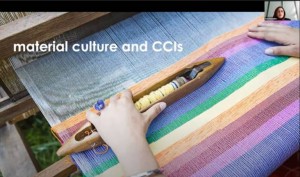 Sara Fiorentino, adjunct Professor of Applied Physics to Cultural Heritage and Post-doc Research Fellow, Department of Cultural Heritage, University of Bologna (Italy), spoke about material culture as a booster for CCIs: objects belonging to material culture are the spokespersons of technological solutions, contamination of tastes, cultural relations and commercial exchanges.
Sara Fiorentino, adjunct Professor of Applied Physics to Cultural Heritage and Post-doc Research Fellow, Department of Cultural Heritage, University of Bologna (Italy), spoke about material culture as a booster for CCIs: objects belonging to material culture are the spokespersons of technological solutions, contamination of tastes, cultural relations and commercial exchanges.
The recovery of elements related to the technological history of materials from our past can be a tool for an active revival of the craft tradition, conveying exchanges of ideas for technological innovation and revitalisation through an active participation of CCIs.
The European Commission through the call HORIZON-RIA-CL2-2022-HERITAGE-01-04 aims to revive and valorise traditional crafts techniques that risk to disappear. Project’s aim is also to Bring together the traditional know-how with new and/or digital technologies to develop improved and new products, services and professions, to set up platforms and develop methodologies, curricula, entrepreneurship skills and courses for vocational training, to create jobs and revive enterprises where tradition meets the future.
The project’s aim is also to create sustainable relationships and networks between research and heritage sites, cultural and creative sectors, institutions, universities and other research institutions, regional and national authorities, enterprises and other relevant stakeholders, in order to promote innovation, jobs and sustainable growth.
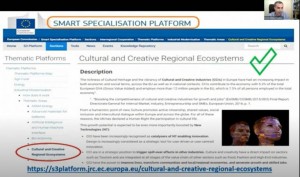 Konstantinos Tzamaloukas, Development Directorate of the Regional Unit of Ilia: his presentation focused on the Cultural and Creative Regional Ecosystems (CCRE-S3), partnership of the Smart Specialisation Platform of the E.C. in which the Region of Western Greece is a co – leading Region and responsible for the Adriatic Ionian geographical area.
Konstantinos Tzamaloukas, Development Directorate of the Regional Unit of Ilia: his presentation focused on the Cultural and Creative Regional Ecosystems (CCRE-S3), partnership of the Smart Specialisation Platform of the E.C. in which the Region of Western Greece is a co – leading Region and responsible for the Adriatic Ionian geographical area.
The transversal dimension of culture, art and CCIs and their impact on territorial development for regions have been presented, outlining the threefold approach and the working groups that are being formulated within this partnership. The project is composed of 5 Working Groups, divided in 2 areas: the first area aims to develop co-investment projects. The partners will define joint investment projects brought by academia, research centres and businesses. The second area “for planning and building CAPACITIES” aims to share experiences in promoting CCI and defining joint plans for building capacities on CCIs that contribute to territorial development. The partners will be able to identify issues of common interest and carry out cooperation projects through the programmes set up for this purpose (Interreg, Erasmus+, Creative Europe). Of particular interest is the WG3 on “smart and circular regions”,which point of interest includes Green Deal, New European Bauhaus, Intelligent Cities Challenge. Indeed, digitalisation at the regional/local level can significantly improve citizens’ quality of life, protect the environment, and contribute to economic growth.
Panel 2: “CITIES AND REGIONS AS CATALYSTS FOR THE DEVELOPMENT OF THE CULTURAL AND CREATIVE SECTOR IN THE ADRIATIC-IONIAN REGION”
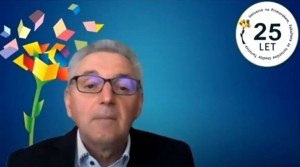
Prof. Igor Jurinčič, Associate Professor of Geography, Faculty of Tourism Studies, University of Primorska, chaired this second panel. His work on cultural heritage started in 2000 developing projects between countries of the Macroregion.
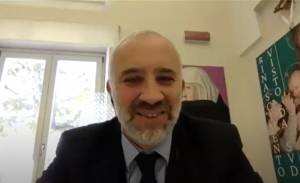 Giovanni Oliva, general director of the Matera-Basilicata foundation, presented the experience of the reality it represents, as a successful action: Matera was nominated as the European capital of culture in 2019 but they started this work several years earlier, already in 2010. “All successful stories need time and strategies, and these strategies, over the years, if necessary, you have to have the courage to change them”.
Giovanni Oliva, general director of the Matera-Basilicata foundation, presented the experience of the reality it represents, as a successful action: Matera was nominated as the European capital of culture in 2019 but they started this work several years earlier, already in 2010. “All successful stories need time and strategies, and these strategies, over the years, if necessary, you have to have the courage to change them”.
Matera can be a model because it has been a success story, also according to the numbers (+ 153% of arrivals in Matera, going from 100,000 tourists to more than a million). Most of them declared that they arrived in Matera driven by the “cultural ferment” that reigns in the city. The foundation’s goal was to improve the quality of life in the city through culture: tourists are not just visitors, but “cultural citizens”. It was not just about “seeing” a place, but about sharing cultural operations and co-creating them. There were obvious mistakes, says Dr. Oliva, but they have tried a different approach than the stage-seated spectator formula: cultural citizens must be part of the event itself, and to do so it is necessary to work on the territory, speak with associations, leave the offices, and walk together.
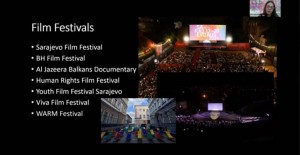 Nataša Kučera, Sarajevo UNESCO City of Film Project Manager (Bosnia and Herzegovina), presented the experience of Sarajevo, focusing on how the field of film contributed to the city’s development, since the local public authorities finally recognised the importance of film and cultural industries on urban development. Sarajevo is an important center of the creative and cultural activities, and the UNESCO City of Film since october 2019, so part of the Creative Cities Network. The most important aspect is the commitment of public authorities in working together with the private sector to make investments and changes to the law on cinematography. This puts Sarajevo and local stories on global screens and attracts international production, creating opportunities for jobs.
Nataša Kučera, Sarajevo UNESCO City of Film Project Manager (Bosnia and Herzegovina), presented the experience of Sarajevo, focusing on how the field of film contributed to the city’s development, since the local public authorities finally recognised the importance of film and cultural industries on urban development. Sarajevo is an important center of the creative and cultural activities, and the UNESCO City of Film since october 2019, so part of the Creative Cities Network. The most important aspect is the commitment of public authorities in working together with the private sector to make investments and changes to the law on cinematography. This puts Sarajevo and local stories on global screens and attracts international production, creating opportunities for jobs.
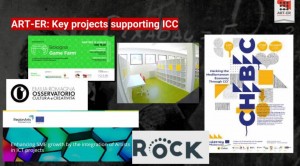 Sveva Ruggiero: her presentation concerned the theme “Fostering innovation in cultural and creative sectors”. In particular she presented the Emilia-Romagna Region strategy and the project ART-ER. Parma and Bologna have been UNESCO City Capitals for Music and Gastronomy, and Modena is now a candidate. Research has been done to map the CCIs and since the 90’s/early 2000’s a journey towards their recognition has begun. The path was long, until arriving, in 2014, to systematic measures and strategies fostering CCIs innovation. CCIs’ innovation has been fostered through an integrated strategy and encouraging the development of innovative solutions. To stimulate cross-sectoral collaborations Emilia Romagna has created EROI: a platform encouraging cross collaborations among different sectors through open innovation dynamics and open laboratories. Monitoring activity is fundamental: S3 monitoring is a platform tracking public funding spent and private investment carried out within S3 priority areas.
Sveva Ruggiero: her presentation concerned the theme “Fostering innovation in cultural and creative sectors”. In particular she presented the Emilia-Romagna Region strategy and the project ART-ER. Parma and Bologna have been UNESCO City Capitals for Music and Gastronomy, and Modena is now a candidate. Research has been done to map the CCIs and since the 90’s/early 2000’s a journey towards their recognition has begun. The path was long, until arriving, in 2014, to systematic measures and strategies fostering CCIs innovation. CCIs’ innovation has been fostered through an integrated strategy and encouraging the development of innovative solutions. To stimulate cross-sectoral collaborations Emilia Romagna has created EROI: a platform encouraging cross collaborations among different sectors through open innovation dynamics and open laboratories. Monitoring activity is fundamental: S3 monitoring is a platform tracking public funding spent and private investment carried out within S3 priority areas.
She left us some recommendations: fostering connections among heterogeneous stakeholders that operate in CCIs at different levels and with different expertise; generating collective knowledge and out of the box solutions; developing a bottom-up type of approach to guide policies and strategies; collecting needs and visions by listening to stakeholders and involving players in pivotal strategies, focusing also on the innovation needs of cultural subsectors.
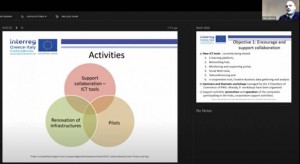 Takis Lybereas, project Manager, made a clear presentation of the Creative @Hubs project, a strategic project funded by the Interreg Greece – Italy programme.
Takis Lybereas, project Manager, made a clear presentation of the Creative @Hubs project, a strategic project funded by the Interreg Greece – Italy programme.
Greece and Italy have huge cultural and natural assets that can contribute to boost their economic growth and improve people’s quality of life. The lead partner of the project is the Region of Western Greece, in cooperation with Region of Epirus, Region of Ionian Islands and Puglia Region – Department of Agriculture, Rural Development and Environmental Protection.
Target Group of the project is creative industries (start-ups, young entrepreneurships, current entrepreneurs, private companies, etc.) and the objectives are: to encourage and support collaboration, with new ICT tools; to organize seminars and thematic workshops; to organize support activities (promotion and operation of the companies participating in the hubs, cooperation support activities). Another objective is the renovation: improve cooperation in the fields of selected areas to help creative entrepreneurs and resources in the field of innovative industries and to promote innovation, through existing local systems (clusters, laboratories, universities, science parks, etc.). Finally, the project aims to enhance entrepreneurship in the development of new creative standards in related industries by small and medium sized businesses and networking by pooling resources related to their development. By the end of the project all infrastructure work will be completed and 8 Hubs will be operational and functioning. The majority of pilots will be organised. The RWG aims to play a major role in the macro-region supporting Creative Industries. Within the EU Strategy for the Adriatic and Ionian Region (EUSAIR), the RWG leads the Cultural and Creative Regional Ecosystems (CCRE). The Creative @Hubs project is only the beginning!
At the end of the Panel, the chairman, Prof. Igor Jurinčič, underlined as all the presentations have put out that not only economic aspects are important but also the improvement for the quality of life, for tourists and inhabitants.
Finally, the 3rd Panel on “INSIGHTS INTO THE CREATIVE AND CULTURAL SECTOR IN THE ADRIATIC AND IONIAN REGION”.
Chaired by Lorenzo Cello, Project Officer, Forum of the Adriatic and Ionian Chambers of Commerce – Forum AIC (AI-NURECC Plus partner).
 Tanja Radusinovic, Director of Projects Department, Chamber of Economy of Montenegro, underlined the long tradition in the CCIs sector, thanks to many active projects. It is a driving sector, in which Montenegro has decided to invest with an interdepartmental approach. A CCIs database has been created and they are starting to think about a workshop on a cross-cutting issue between CCI and tourism, in coordination with all the stakeholders. The point of the database is to join forces. Cultural and Creative Industries (CCIs) are recognized as part of the global economy. They have growing importance for sustainable local development. The exploitation of their full potential depends on several issues concerning their entrepreneurial dimension and the context where they operate.
Tanja Radusinovic, Director of Projects Department, Chamber of Economy of Montenegro, underlined the long tradition in the CCIs sector, thanks to many active projects. It is a driving sector, in which Montenegro has decided to invest with an interdepartmental approach. A CCIs database has been created and they are starting to think about a workshop on a cross-cutting issue between CCI and tourism, in coordination with all the stakeholders. The point of the database is to join forces. Cultural and Creative Industries (CCIs) are recognized as part of the global economy. They have growing importance for sustainable local development. The exploitation of their full potential depends on several issues concerning their entrepreneurial dimension and the context where they operate.
Business support organizations have an important role in promoting and supporting cultural and creative industries. There are many projects funded by the European Commission which have significant impact to raise awareness and improve the ecosystem for development of cultural and creative industries. The Chamber of Economy of Montenegro implemented project BACAR whose goal was creating cultural and creative industries clusters in Montenegro and establishing networks in the cross border area (Croatia – Bosnia and Herzegovina – Montenegro).
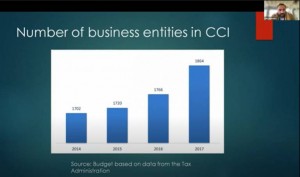 Edin Jašarović, Dean of the Faculty of Dramatic Arts – Cetinje, University of Montenegro: in Montenegro recent activities of the Ministry of culture introduced some new instruments to support cultural entrepreneurship. Cultural policy in Montenegro has significantly changed from 2018. This is due to strong orientation towards the new creative sector development policy. According to the budget, the gross value added of CCI industries in 2017 amounted to EUR 53 million, which represents 1.5% of gross value added at the level of Montenegro.
Edin Jašarović, Dean of the Faculty of Dramatic Arts – Cetinje, University of Montenegro: in Montenegro recent activities of the Ministry of culture introduced some new instruments to support cultural entrepreneurship. Cultural policy in Montenegro has significantly changed from 2018. This is due to strong orientation towards the new creative sector development policy. According to the budget, the gross value added of CCI industries in 2017 amounted to EUR 53 million, which represents 1.5% of gross value added at the level of Montenegro.
Given that CCIs are not recognized as a single sector, there is no single institutional and strategic framework governing this area, but the responsibilities for regulation and development are divided depending on what certain activities belong to. All of the above indicates the need for intersectoral cooperation in this area. Education policies need to be tailored to the needs of the market, especially when it comes to the CCI sectors. The interdisciplinary nature of CCI requires appropriate solutions, ie. influences the encouragement of changes in the education system in order to respond to the increasingly complex needs related to this area.
Assessing the economic effects of cultural and creative industries in Montenegro, the data led to the conclusion that CCIs in Montenegro are significantly below their potential. The Ministry of Culture of Montenegro initiated a strategic impulse on the development of a wide-range of “Creative hubs” in Montenegro, based in the coastal, central and northern region, with the main focus on Residential arts and the production of services under Creative industries.
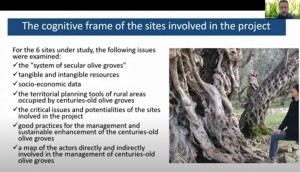 Endrit Kullaj, Professor at the Agricultural University of Tirana and Technical Coordinator of the Interreg project CROSS BORDER OL (Albania).
Endrit Kullaj, Professor at the Agricultural University of Tirana and Technical Coordinator of the Interreg project CROSS BORDER OL (Albania).
“SMART AND SUSTAINABLE CROSS-BORDER Tourism Plan for the centuries-old olive groves of Albania, Montenegro, Molise and Puglia” is a project that involves these areas characterized by monumental olive groves. Main project objective is to boost the attractiveness of natural and cultural assets to promote sustainable tourism development based on the natural asset of the landscape with AOOs (Ancient Olive Orchards). Specific objectives are: the identification of areas with AOOs, the conservation of landscape with ancient olive trees, the valorization of areas with AOOs. So, not only AOOs have been cataloged, described, georeferenced and mapped, but also other values that characterize the area have been taken into consideration. In fact, socio-economic data have also been collected, in order to evaluate such areas and prepare a commercial plan. The scope is to encourage the development of these areas with sostenible measures and to promote responsible tourism. The “Smart and Sustainable Cross-border Tourism Plan ” makes and promotes a network of cultural and natural heritage, and traces new development processes in rural areas of high landscape value.
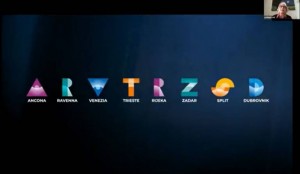 Cristiana Colli, Independent Consultant on behalf of Central Adriatic Ports Authority, lead partner of the Interreg project REMEMBER (Italy).
Cristiana Colli, Independent Consultant on behalf of Central Adriatic Ports Authority, lead partner of the Interreg project REMEMBER (Italy).
The composition of the Macro-region is interesting because it outlines a new model of development based on culture, and the sea is the connection that unites these countries. There is a lot of concreteness in this meta-region, there are many investments and committed stakeholders. The water that bathes the two coasts is the scenario where many things happen: the port is a cultural hub, guards heritage, plays its role as a useful infrastructure, becoming the gateway to a city. The port is a community of communities and becomes a design space, the port cities of the Adriatic are therefore connected by this thread, even if they contain different beauties, but they are hinges and junctions. ADRIO brings together 8 port cities (4 Italian and 4 Croatian) that face the same challenges: sustainability, first and foremost. ADRIO is a digital platform but also a physical space, an “on-life” project. Tradition and culture, stories and heritage are the three themes within which the same cities move. Augmented reality allows travelers to experience a contemporary Adriatic rich in hybridizations. The Adriatic and macro-regional ecosystems are ready to define new maps and new geographies.
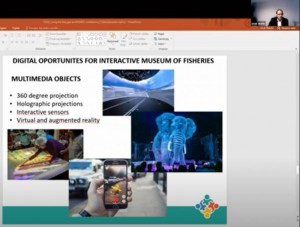 Iztok Škerlič, Director of the Public agency for promotion of entrepreneurship and developing projects of Municipality of Izola (Slovenia).
Iztok Škerlič, Director of the Public agency for promotion of entrepreneurship and developing projects of Municipality of Izola (Slovenia).
He presented the project “Digitisation of cultural heritage of Fishing and Fish Industry for creation of virtual touristic points of interest in EUSAIR, LIVING THE SEA 4.0”
The project idea is supported by the Slovenian Ministry of Economic Development and Technology as well as the Ministry of Agriculture, Forestry and Food. The project has a clear impact on the macroregion, and a local impact. The flagship will use digitization for preservation of natural and cultural heritage as an important tool that will establish the foundation of a new touristic approach for managing the burden of coastal areas caused by touristic flows, climate changes, traffic pollution, and similar.
The project proposes a diversification of touristic offer, based on digitalisation of fishery heritage in all its spectres. This will widen the accessibility of the common fishery history to the interested public and represent an important touristic product in the whole EUSAIR area. Another aim of LIVING THE SEA 4.0 is to improve the quality of already recognized tourist attractions with digital and interactive technologies, as well as to create new ones. Finally, it aims in fostering Adriatic-Ionian cultural heritage and new products for the EUSAIR in the framework of the already identified thematic touristic and historical Routes.
Watch the Video Recording of the Event!
Here you will find the speakers’ materials:
Paolo Seri: A functional perspective on CCIs
Aleksandra Djukić: DANUrB+ presentation
Sara Fiorentino: The Hidden Value: material culture as a booster for CCIs
Konstantinos Tzamaloukas: CCRE-S3 Presentation
Nataša Kučera: Sarajevo UNESCO City of Film_Presentatation
Sveva Ruggiero: Fostering innovation in cultural and creative sectors: the Emilia-Romagna Region strategy
Takis Lybereas: Creative@Hubs – Project overview
Endrit Kullaj: SMART AND SUSTAINABLE CROSS-BORDER Tourism Plan
Iztok Škerlič: Living the Sea
Giovanni Oliva: Matera 2019: Open Future
